Old-world bacon's exceptional taste comes from its meticulous dry-curing process, where salt and time work together to transform raw pork belly into a flavor-rich delicacy. You'll find that traditional methods use a precise blend of salt, sugar, and curing agents while maintaining strict temperature control at 38-40°F. The slow curing process, typically 1.5 days per pound, allows beneficial bacteria to develop complex flavors. When you combine this with traditional smoking techniques using hardwoods like hickory or apple, you get bacon with unmatched depth and character. There's much more to discover about this time-honored craft's secrets.
The Art of Dry Curing
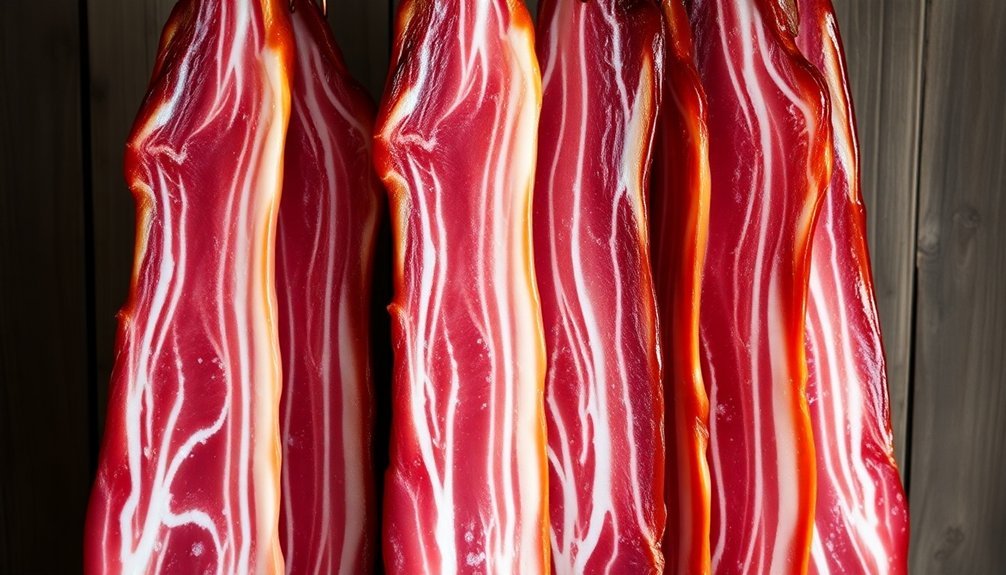
Bacon's distinctive old-world flavor comes alive through the traditional art of dry curing. This time-tested method involves rubbing your pork belly with a precise mixture of salt, sugar, pepper, and a curing agent like Insta-Cure #1.
You'll need to carefully measure your ingredients – for a 5-pound belly, use ½ cup each of salt and brown sugar, along with 1 tablespoon of black pepper and 1 teaspoon of Insta-Cure #1. Minimal equipment is needed to achieve professional results, making this an ideal project for beginners.
The magic happens when you thoroughly coat every surface of the meat with this mixture. Once you've applied the cure, wrap the pork belly tightly in plastic wrap or seal it in a large Ziplock bag.
You'll need to refrigerate it for 6-7 days, checking periodically to guarantee even curing throughout the meat.
After curing, you can test your bacon by frying a small piece. If it's too salty, don't worry – a quick soak in cold water will adjust the flavor.
The final step involves drying the surface overnight in your refrigerator. This preparation guarantees your bacon will develop that authentic old-world taste that's become increasingly rare in modern times.
Salt's Role in Preservation
Salt's power to draw moisture from meat is your key to successful bacon curing, as it creates an environment where harmful bacteria can't survive.
You'll want to maintain a consistent temperature between 38-40°F throughout the curing process, which allows the salt to penetrate the meat effectively.
With proper temperature control and salt application, you're ensuring that the extraction process works evenly through every portion of your bacon. The process requires approximately 1.5 days per pound of meat for optimal curing results.
Salt's Essential Extraction Process
Through the ages, the ancient art of preserving meat has relied on salt's remarkable extraction process. You'll find that when salt penetrates meat tissue, it creates a fascinating chain reaction that's essential for preservation. The salt draws out moisture while simultaneously transforming proteins, making it impossible for harmful bacteria to thrive.
When you're curing meat the old-world way, you'll need to maintain precise salt concentrations. The process works best when you use about 10 pounds of salt for every 100 pounds of meat, or if you're using a brine solution, it should be strong enough to float an egg. Traditional methods relied on beneficial bacteria like Staphylococci and Lactobacilli, which naturally generate nitric oxide during the curing process. Medieval preservers enhanced their curing mixtures with saltpeter types to ensure optimal food safety.
| Process Stage | Salt's Action | Result |
|---|---|---|
| Initial Contact | Salt meets meat surface | Begins moisture extraction |
| Penetration | Salt enters tissue | Protein denaturation starts |
| Moisture Release | Water drawn out | Creates hostile bacterial environment |
| Stabilization | Salt concentration equalizes | Meat preservation complete |
Controlling Temperature During Cure
Temperature control plays an essential role when you're curing meat the traditional way. You'll want to maintain a consistent temperature between 38°F and 40°F (3°C to 4°C) throughout the curing process, which is why using your refrigerator is ideal. This temperature range prevents harmful bacteria from growing while allowing the cure to work effectively.
When you're curing bacon, you'll notice that the process takes longer at cooler temperatures. Dry curing typically requires 6-7 days, while wet curing needs 10-14 days. Don't be tempted to speed up the process by raising the temperature, as this can lead to uneven curing and increased bacterial risk.
The salt in your cure works better at cooler temperatures, helping to reduce water activity and dehydrate bacterial cells.
You'll find that proper temperature control guarantees the curing salts (sodium nitrite or nitrate) can effectively preserve your meat. It's vital to maintain stable temperatures throughout the process, as fluctuations can compromise the cure's effectiveness and impact your bacon's final texture, tenderness, and juiciness.
Temperature and Time Control
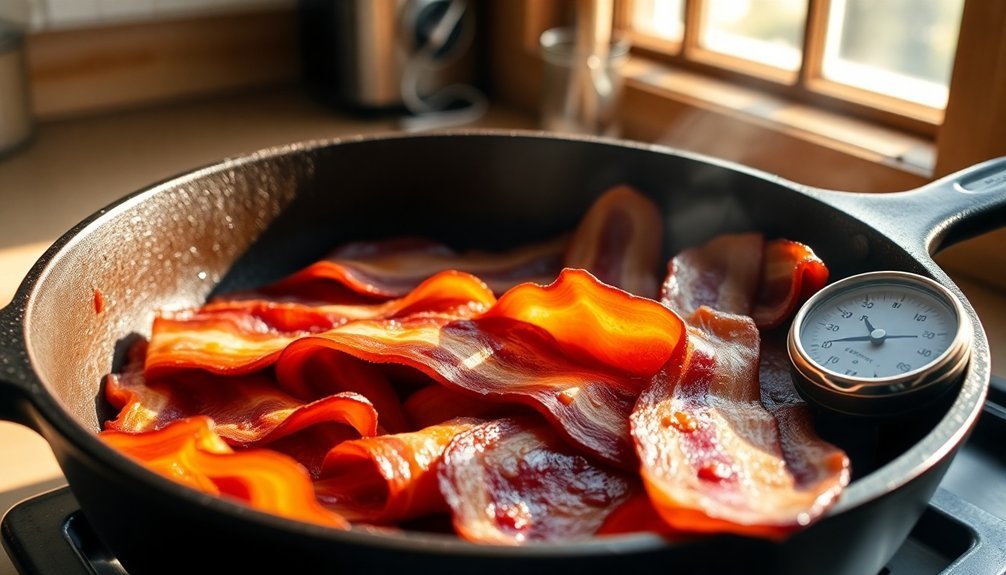
Mastering old-world bacon requires precise control of both time and temperature throughout the process. During the three-week curing phase, you'll need to keep the meat in a cool environment while flipping it every 2-3 days to guarantee even distribution of the brine solution.
You'll know your brine is properly balanced when it can float a raw egg.
The smoking phase demands careful attention to temperature control, though you'll focus more on monitoring the process to prevent over-smoking or burning.
Whether you're smoking for several hours or days, you'll need to maintain consistent heat to develop that signature smoky flavor.
When it's time to cook your bacon, you'll want to start with a cold pan or oven. If you're using the stovetop, cook on low-to-moderate heat for 10-15 minutes.
For oven cooking, let the bacon heat up with the oven for 20-25 minutes. If you prefer grilling, use a two-zone fire and cook for 10-15 minutes per side.
For sous vide enthusiasts, set your temperature to 145°F and cook for at least 8 hours.
Remember to chill the bacon after cooking to set its texture before slicing.
The Chemistry of Nitric Oxide
While precise temperature control shapes bacon's texture and taste, the real magic happens at the molecular level with nitric oxide. When you cure bacon, nitrites convert into nitric oxide, which binds with the iron in meat to create that signature pinkish color you know and love.
You'll find that nitric oxide does more than just make bacon look appealing – it's essential for food safety, helping eliminate dangerous pathogens like botulism and listeria. During the curing process, the amount of nitrite reduces considerably, typically ending up at about 10 parts per million in the final product.
When you cook bacon, the nitric oxide interacts with fats and proteins to create complex flavor compounds like 2,5-dimethylpyrazine and 2-ethyl-5-methylpyrazine.
These reactions, combined with the Maillard reaction between sugars and amino acids, give bacon its distinctive aroma and taste. You'll notice various volatile compounds, including hydrocarbons, alcohols, ketones, and aldehydes, that contribute to bacon's irresistible smell.
While there's been concern about nitrosamines forming during cooking, they're usually undetectable in properly prepared bacon, especially when you include vitamin C-rich foods in your meal.
Traditional Smoking Methods
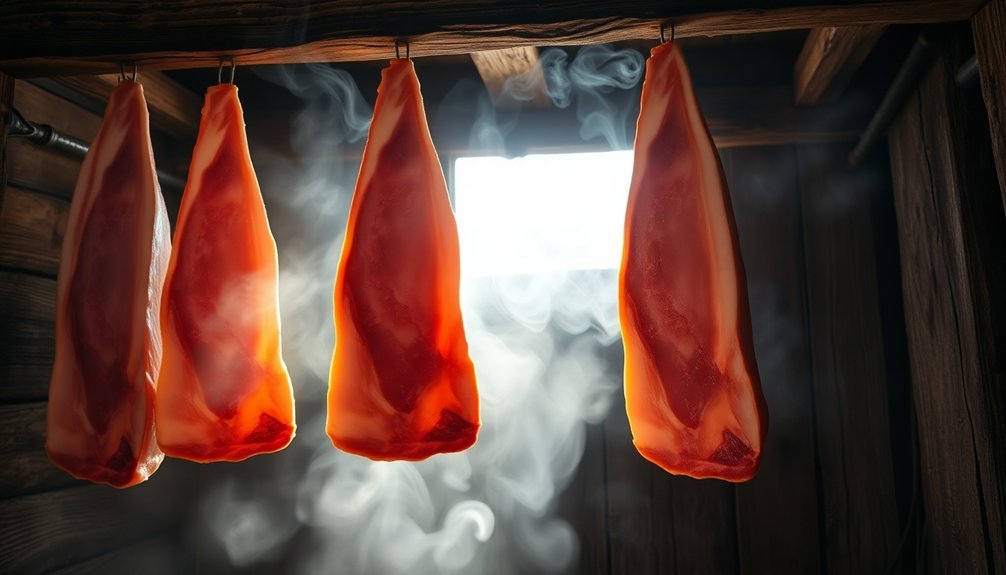
Traditional bacon smoking remains an art that starts with the right equipment and wood selection.
You'll need a proper smoker or smokehouse with good ventilation, along with meat hooks or racks to hang your pork belly. Temperature control is essential, so keep a reliable thermometer handy to monitor both the smoker and the meat's internal temperature.
Your choice of wood notably impacts the final flavor. You'll want to stick with hardwoods like apple, maple, hickory, beech, or oak, as they produce clean, sweet smoke.
Don't use softwoods – they'll leave your bacon with an unpleasant, sooty taste from their resinous smoke.
Before you start smoking, you'll need to rinse the cured pork belly and let it develop a pellicle in the refrigerator.
Set your smoker to 160-170°F and smoke the meat for about six hours, aiming for an internal temperature of 150-155°F. You can break this into multiple sessions if needed.
Once you've finished smoking, let your bacon rest in the refrigerator to allow the smoke flavor to fully develop.
When you're ready to enjoy it, slice and cook it until crispy through pan-frying or oven baking.
Selecting Quality Pork Belly
Quality pork belly's signature traits lie in its perfect balance of fat and lean meat. You'll want to look for cuts with a fat content of around 31% or higher, as these offer superior technological and eating qualities compared to leaner alternatives.
When selecting your pork belly, verify it's approximately 1 inch thick, which provides ideal cooking versatility and moisture retention.
Pay attention to the meat's appearance and fat distribution. You'll know you've found a good cut when you see clean, fresh-looking skin and well-marbled meat. The fat should be white and firm, while the meat should have a pinkish-red hue.
If you're able to choose from different breeds, Yorkshire and Tamworth pigs are known for producing exceptional bacon.
Check that the cut has uniform thickness throughout, as this guarantees even cooking and better flavor development.
Higher fat content contributes to enhanced flavor compounds, particularly those associated with rich, oily notes. You'll also experience less cooking loss and better moisture retention with fattier cuts, resulting in juicier, more tender meat that scores higher in overall eating quality.
Perfect Lean to Fat Ratio
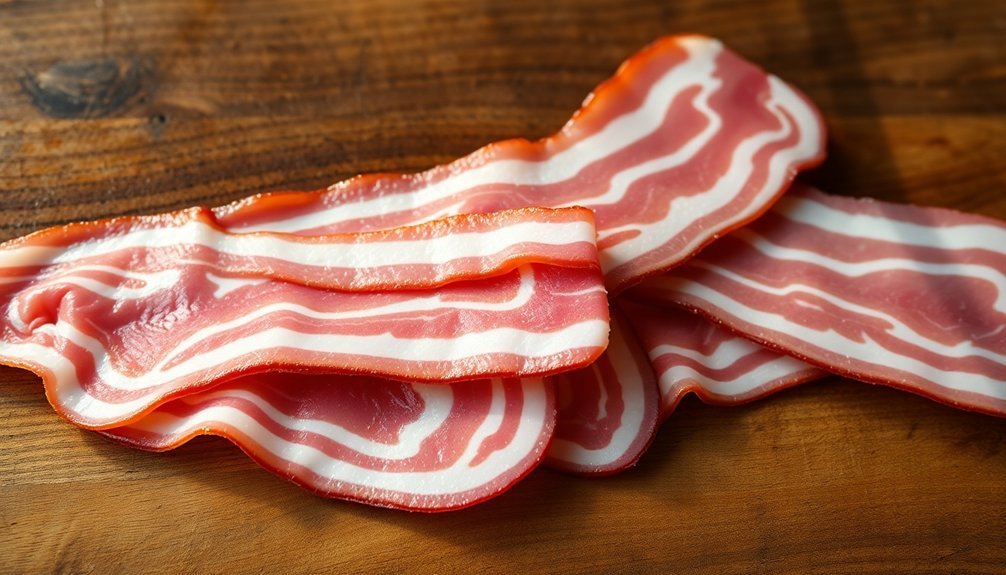
You'll find that the perfect bacon slice showcases a harmonious 40-60 lean-to-fat ratio, creating layers of deep, savory flavors that develop during cooking.
When you're examining bacon slices, look for consistent marbling throughout each strip, as this guarantees an even cooking process and that satisfying crunch in every bite.
The visual appearance of well-distributed fat striping isn't just for show – it's a reliable indicator that you're getting bacon with ideal texture and taste potential.
Balance Creates Flavor Depth
The perfect balance between lean meat and fat creates bacon's signature depth of flavor, with traditional ratios hovering around 70% fat content compared to today's leaner 45-55%.
When you cook bacon, the fat breaks down and combines with sugars and amino acids, producing that distinctive sweet, buttery, and salty flavor profile you've come to love. The cooking process renders most of the fat, creating those intense smoky and umami notes characteristic of old-world bacon.
The breed and sex of pigs greatly influence bacon's taste and texture. Barrows produce bacon with more unsaturated fatty acids than gilts, while fatter genetic lines yield better smokehouse results.
The type of wood used in smoking, whether it's hickory, oak, or applewood, adds another layer of complexity to the flavor.
- Cook bacon in a single layer on a griddle or cast iron skillet
- Flip frequently for even cooking and ideal flavor development
- Look for traditionally cured and smoked bacon for authentic taste
- Consider the wood type used in smoking for different flavor profiles
- Choose bacon with visible fat marbling for the best flavor depth
Marbling Enhances Texture Quality
Building on the art of traditional bacon-making, marbling plays a central role in creating that perfect bite you crave. When you look at quality bacon, you'll notice a delicate balance of intramuscular fat weaving through the lean meat, ideally hitting that sweet spot of 50-55% lean to 45-50% fat ratio.
This intricate pattern isn't just for show – it's essential for delivering the texture and mouthfeel you expect from premium bacon.
You'll find that the marbling's quality depends heavily on both the pig's genetics and diet. When you're selecting bacon, look for pieces from grain-fed breeds known for superior fat distribution.
The fatty acids within these marbled streaks don't just contribute to texture; they're flavor carriers that release during cooking, enhancing the bacon's savory, umami notes.
When you cook marbled bacon, the intramuscular fat slowly renders, creating that perfect combination of crispy and tender.
The melting fat triggers the Maillard reaction, which develops those complex flavors you associate with traditionally-cured bacon.
That's why you'll notice old-world bacon has a distinctly different texture and taste compared to mass-produced varieties.
Visual Appeal Matters Most
When judging premium bacon quality, visual appeal immediately signals what you can expect from each slice. You'll notice that old-world bacon maintains a perfect balance of fat and lean meat, with approximately 50-55% lean and 45-50% fat content. This ideal ratio isn't just about looks – it's vital for peak cooking performance and flavor development.
You'll want to look for slices that display firm, dry characteristics rather than wet, oily surfaces. The best bacon features bright white fat bands contrasting beautifully with reddish-pink lean portions. You'll also notice that premium cuts maintain uniform length and rectangular shapes without valleys or V-shaped regions.
- Examine the fat-to-lean distribution across multiple slices to guarantee consistency
- Look for bright white fat and vibrant reddish-pink lean portions
- Check that slices are rectangular and uniform in shape
- Avoid pieces showing separation between fat and lean sections
- Reject slices with cracked or shattered fat portions
Whether you're a home cook or professional chef, these visual cues help you select bacon that'll deliver the perfect balance of flavor, texture, and cooking performance that's characteristic of traditional old-world standards.
Essential Flavor Compounds
Understanding bacon's complex flavor profile starts with its essential chemical compounds and reactions. When you cook bacon, you're initiating the Maillard reaction, where amino acids and reducing sugars transform under heat to create that signature golden-brown color and rich flavor you love.
As your bacon sizzles in the pan, multiple chemical processes unfold. The breakdown of sugars and amino acids produces aldehydes, furans, and ketones – compounds that give bacon its distinctive aroma and taste.
You'll notice the fat rendering out, and that's vital because these fatty acids interact with amino acids to develop deep, savory flavors.
The magic doesn't stop there. The smoking process, typically done with hardwoods like hickory or oak, infuses the meat with complex compounds that create that unmistakable smoky aroma.
When combined with the natural umami from the pork and the salt cure, you're getting a perfect storm of flavor compounds. Every bite delivers a harmonious blend of sweet, salty, and savory notes, while the rendered fats carry these flavors across your palate, creating that memorable bacon taste you crave.
The Cold Smoking Process
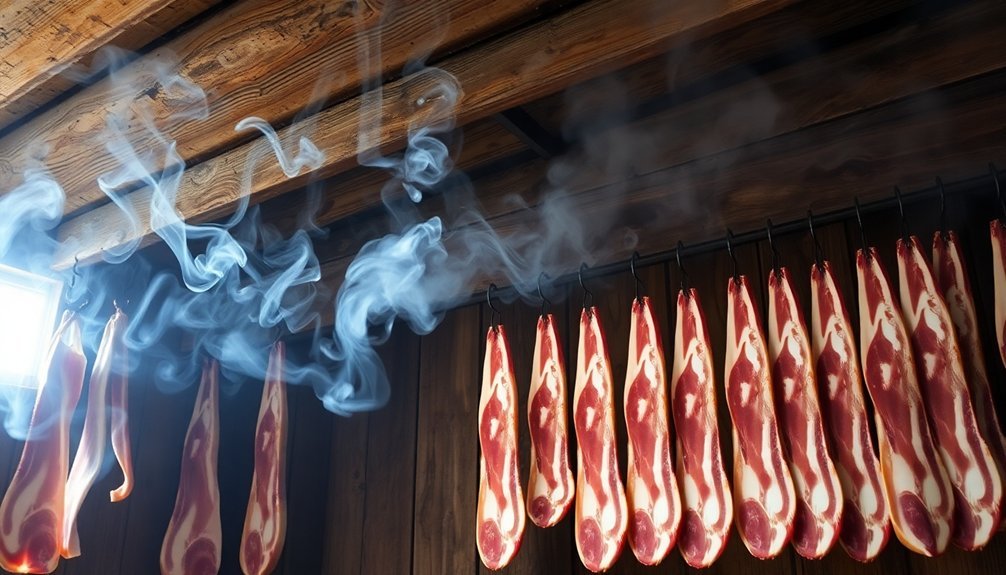
Cold smoking transforms ordinary bacon into a deeply flavorful delicacy through a precise, temperature-controlled process. You'll need to maintain temperatures between 68°F and 86°F while generating a light, steady stream of smoke from woods like hickory, applewood, or mesquite. The process can span from 4 hours to several days, depending on your desired flavor intensity.
To achieve the best results, you'll want to prepare your bacon by cleaning and trimming excess fat, then make sure it's thoroughly dried before smoking. Your smoking chamber needs proper ventilation to allow smoke to circulate evenly around the meat.
During smoking, you'll monitor the process carefully, often smoking in intervals with rest periods in between, until you've achieved a 20-30% weight loss.
- Set up your cold smoker or modified grill with excellent ventilation
- Choose your wood type carefully – each variety imparts distinct flavors
- Control temperature strictly, never exceeding 90°F
- Smoke in intervals, allowing rest periods between sessions
- Let your bacon mature after smoking to develop complex flavors
After smoking, you'll need to clean and dry your bacon thoroughly before storing it in a well-ventilated area, where the flavors will continue to mature and develop over time.
Proper Storage Techniques
Properly storing your cold-smoked bacon guarantees you'll preserve its rich flavors and extend its shelf life. You've got several reliable storage methods to choose from, each offering distinct advantages for your bacon preservation needs.
If you're planning long-term storage, pressure canning is your best bet. Roll individual bacon strips in parchment paper, place them in wide-mouth jars with a 1-inch headspace, and process at 10 pounds of pressure for 90 minutes.
For a more convenient option, you can freeze your bacon after cooking it slightly under your preferred doneness. Flash freeze it on cookie sheets to prevent sticking, then transfer to airtight containers for up to six months.
For shorter storage periods, refrigeration works well. Store your cooked bacon in airtight containers after patting off excess grease, and it'll last about a week.
If you're interested in creating bacon bits, try dehydrating your fully cooked bacon. Run your dehydrator at 160°F for 8 hours, regularly patting away grease and moisture.
You'll want to store your dehydrated bacon in the refrigerator or freezer in an airtight container to maintain its quality.
Cooking for Maximum Flavor

You'll get the best old-world bacon taste by controlling your cooking temperature, starting low to render the fat slowly before increasing the heat.
Cast iron skillets work beautifully for this purpose, distributing heat evenly while developing a perfect crust through the Maillard reaction.
Let your bacon sizzle gently at first, then raise the heat gradually to achieve that ideal balance of crispy exterior and tender, flavorful interior.
Temperature Control Matters
Getting the temperature right can make or break your bacon's flavor and texture. Whether you're pan-frying, baking, or smoking, controlling heat determines how evenly your bacon cooks and how much flavor it retains.
In pan-frying, starting with a cold pan over low heat prevents rapid fat rendering, giving you that perfect balance of crispy and chewy. When you're baking, a consistent 350°F guarantees even cooking throughout, and you'll get pure white bacon grease without those burnt bits.
For that authentic old-world taste, temperature control during curing and smoking is essential. You'll want to keep the meat refrigerated during curing for proper salt absorption, followed by carefully controlled smoking temperatures for peak flavor development.
- Start with a cold pan when frying to prevent rapid fat rendering
- Set your oven to 350°F and let it fully preheat before baking
- Stack bacon in two-strip piles for even heat distribution
- Keep meat consistently cold during the curing process
- Use medium to medium-low heat when grilling to achieve proper browning
While microwaving might be quick, it won't give you that authentic old-world flavor. Instead, focus on slower, temperature-controlled methods that allow flavors to develop fully.
Fat Renders Slowly First
True bacon mastery begins with patient fat rendering, a process that reveals the meat's deepest flavors and creates that coveted combination of crispy exterior and tender interior.
You'll want to start by cutting your thick-sliced or slab bacon into small, one-inch pieces to maximize the surface area for rendering.
Set your heavy-bottomed pan over low to medium heat – this isn't a race. You'll notice the fat begins to slowly release from the meat, creating small pools of clear liquid.
Don't rush this process; it typically takes 10-15 minutes for bacon, though larger quantities of pig fat can require several hours. Keep stirring the pieces occasionally to guarantee even cooking and prevent any unwanted charring.
You'll know you're on the right track when you see the fat separating cleanly from the meat, leaving behind increasingly crispy bits.
If you're after a more subtle smoky flavor, try blanching the bacon pieces in boiling water before rendering.
Once the fat has fully rendered, strain it through a fine sieve and save those crispy bits – they're delicious as toppings or snacks.
The rendered fat will store well in a glass container in your refrigerator.
Cast Iron Works Best
When seeking the pinnacle of bacon perfection, a well-seasoned cast iron skillet stands as your most reliable ally. These traditional pans excel at heat retention and distribution, ensuring your bacon cooks evenly without scorching.
You'll notice the difference as the fat renders slowly and consistently, creating that perfect balance of crispy exterior and tender meat. Cast iron's natural properties protect your bacon from direct heat while promoting ideal caramelization.
You'll find that cooking at low to medium heat allows the bacon to develop that sought-after golden-pink color while building layers of flavor. As you cook, the bacon's fat seasons your skillet, creating a natural non-stick surface that gets better with each use.
- Use your cast iron skillet on both stovetop and in the oven for maximum versatility
- Save the rendered bacon grease for enhancing other dishes like roasted potatoes
- Keep the heat low to medium for peak fat rendering and crispiness
- Monitor your bacon easily thanks to the skillet's wide cooking surface
- Maintain consistent temperature throughout cooking for that perfect golden-pink color
Hickory Smoke Benefits
Hickory smoke packs a powerful punch of benefits that extend far beyond its delicious flavor profile. When you smoke bacon with hickory wood, you're getting a complex blend of phenolic compounds, aldehydes, and other chemical components that work together to create both exceptional taste and remarkable preservation properties.
You'll find that hickory smoke acts as a natural preservative, fighting off harmful bacteria and fungi that could spoil your bacon. It's particularly effective at preventing lipid oxidation, which helps maintain the meat's texture and extends its shelf life.
What's more, you're getting powerful antioxidant properties that can help combat disease-causing free radicals. The health benefits you'll receive from hickory-smoked bacon might surprise you. Unlike some other wood types, hickory smoke has shown protective effects against various organ damage and doesn't trigger allergic responses.
It's also been found to produce fewer carcinogens compared to smoking with woods like beech. Additionally, you're supporting sustainable practices since hickory smoking often utilizes wood that would otherwise go to waste, making it an environmentally conscious choice for your bacon-making process.
Aromatics and Taste Development
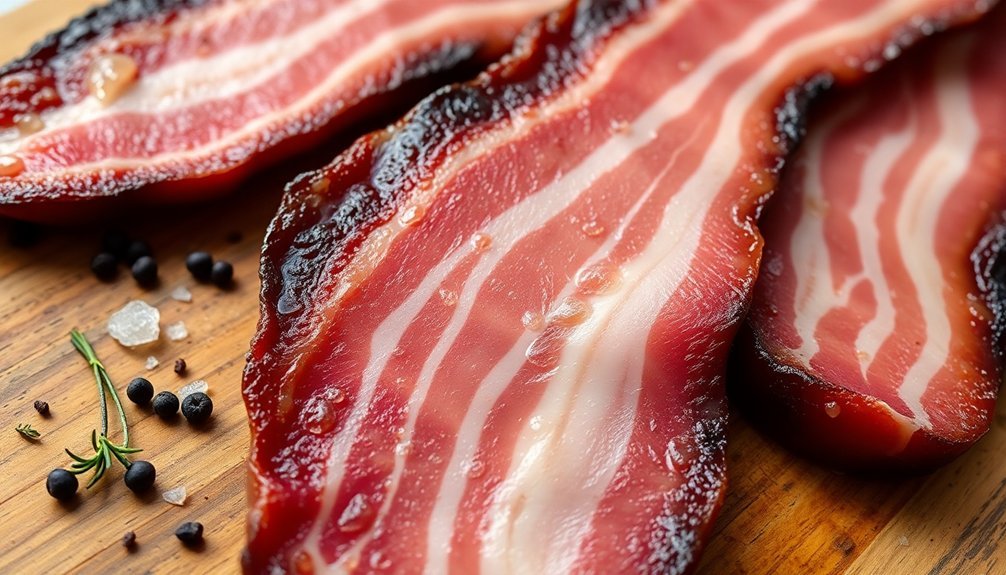
Ever wonder what creates that irresistible bacon aroma that draws you to the kitchen? It's the magic of the Maillard reaction, where sugars and amino acids dance together when heated, creating that signature scent you can't resist.
When bacon hits the pan, its fat breaks down and mingles with these compounds, producing a symphony of aromatic flavors.
The taste development starts long before cooking, during the curing process. You'll find a careful balance of salt, sugar, and sodium nitrite in the brine, which transforms raw pork belly into bacon.
As the meat cures, the lean portions develop a rich, dark red color, indicating it's ready for cooking.
When you cook bacon, you're revealing layers of complex flavors. The heat releases fatty acids that contribute to both taste and texture, while the smoking process adds depth to the overall profile.
- Cook bacon over medium-high heat for ideal flavor development
- Let strips cook in a single layer, flipping frequently for even crispiness
- Look for a balance of lean and fatty portions for the best taste experience
- Choose hardwood-smoked varieties for clean, authentic flavor
- Allow proper fat rendering to enhance the overall taste profile
Frequently Asked Questions
Why Do Some People Soak Bacon in Water Before Cooking?
You'll get less greasy, less salty bacon when you soak it in water first. It'll reduce splatter while cooking, make cleanup easier, and help you achieve more even cooking with a crispy finish.
Can Old-World Bacon Recipes Be Adapted for Different Cultural Dietary Restrictions?
Yes, you can adapt old-world bacon recipes by using halal/kosher meats, plant-based alternatives, or gluten-free ingredients. You'll need to modify curing methods and seasonings while maintaining traditional smoking techniques for authentic flavors.
How Does Altitude Affect the Traditional Bacon Curing Process?
At higher altitudes, you'll find your bacon cures faster due to lower air pressure and humidity. You'll need to adjust curing times and monitor moisture carefully to prevent over-drying and guarantee ideal flavor development.
What Makes European Bacon Different From American-Style Bacon?
You'll find European bacon comes from the pig's leaner loin or back, while American bacon's from the fatty belly. It's thicker, less greasy, and chewier, with different curing methods that affect flavor.
Does the Pig's Diet Affect the Final Taste of Old-World Bacon?
Yes, your pig's diet directly impacts bacon flavor. When you feed them quality grains and balanced nutrients, you'll get richer-tasting meat. Heritage breeds especially benefit from proper feed, producing more flavorful bacon.
In Summary
You've now discovered the secrets behind old-world bacon's irresistible taste: the patient art of dry curing, precise temperature control, and traditional smoking methods. When you combine carefully controlled nitric oxide reactions with the perfect mix of salt, time, and aromatic wood smoke, you're recreating a centuries-old process that develops deep, complex flavors. Store and cook it properly, and you'll experience bacon as your ancestors did.

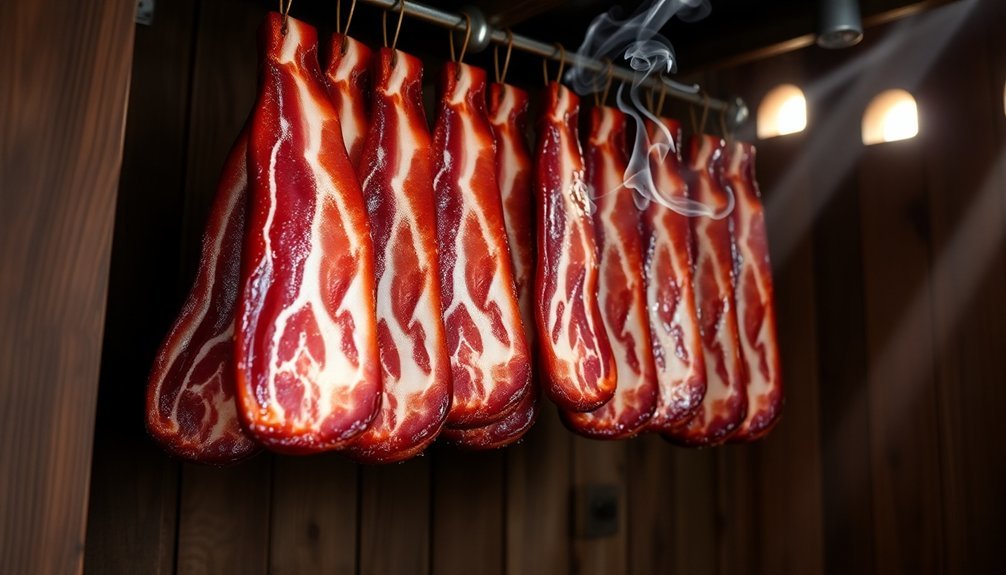



Leave a Reply